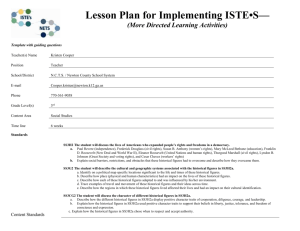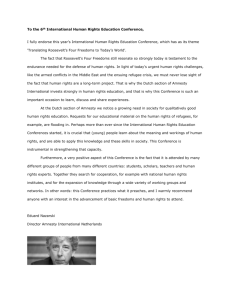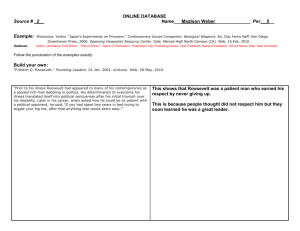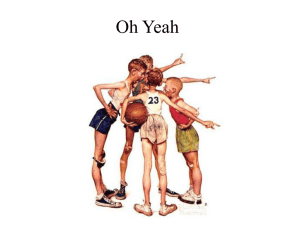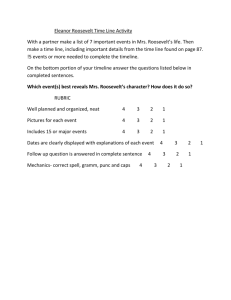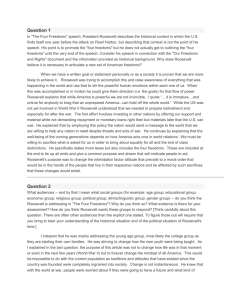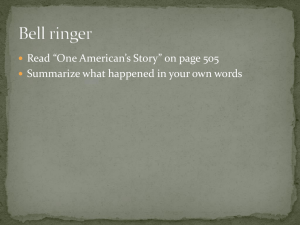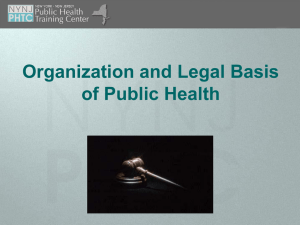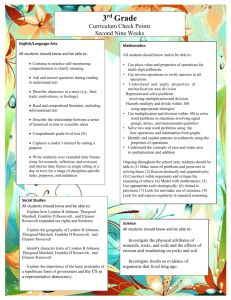Grade Three - Atkinson County Schools
advertisement
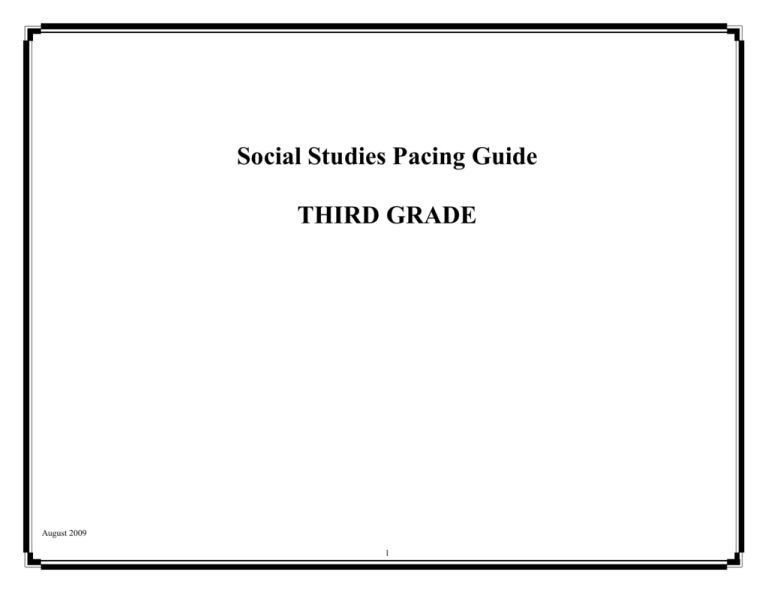
Social Studies Pacing Guide THIRD GRADE August 2009 1 Grade/Course: Grade Three – Our Democratic Heritage Standards: H1a,b,c; G1c,d; CG1a,b,c 3 weeks Standards: E1a,b,c,d; E2a; E3a,b,c,d; E4, G1a, G1a,b 4 weeks Standards: H2a,b; G2a,b,c,d,e; CG2; E1a,b,c,d; E2; E3a,b 1½ weeks Standards: H2a,b; G2a,b,c,d,e; CG2; E1a,b,c,d; E2; E3a,b 1½ weeks Unit One: Unit Two: Unit Three: Unit Four: Roots of Our Democracy Our Economy Paul Revere Frederick Douglass Themes and Concepts/Topics: Themes and Concepts/Topics: Themes and Concepts/Topics: Themes and Concepts/Topics: Governance direct democracy representative democracy republic separation of powers levels of government Economic Choices productive resources goods and services taxes interdependence trade producer consumer resource allocation market economy marketplace currency spending and saving Contributions independence patriot Contributions civil rights freedom abolition Geographic Setting major U.S. rivers major U.S. mountains Economic Choices productive resources role of government interdependence Geographic Setting Athens, Greece latitude and longitude Everyday Life architecture Olympic Games Geographic Setting Boston, Massachusetts Character diligence liberty Everyday Life silversmith Geographic Setting Baltimore, Maryland Rochester, New York Underground Railroad Character liberty justice freedom of conscience Everyday Life learning to read newspaper editor Economic Choices productive resources role of government interdependence August 2009 2 Standards: H2a,b; G2a,b,c,d,e; CG2; E1a,b,c,d; E2; E3a,b 1½ weeks Standards: H2a,b; G2a,b,c,d,e; CG2; E1a,b,c,d; E2; E3a,b 1½ weeks Standards: H2a,b; G2a,b,c,d,e; CG2; E1a,b,c,d; E2; E3a,b 1½ weeks Standards: H2a,b; G2a,b,c,d,e; CG2; E1a,b,c,d; E2; E3a,b 1½ weeks Unit Five: Unit Six: Unit Seven: Unit Eight: Susan B. Anthony Mary McLeod Bethune Franklin Roosevelt Eleanor Roosevelt Themes and Concepts/Topics: Themes and Concepts/Topics: Themes and Concepts/Topics: Themes and Concepts/Topics: Contributions Women’s suffrage voting Contributions founded a school/college for African-American females Geographic Setting Rochester, New York Seneca Falls, New York Geographic Setting Daytona Beach, Florida Contributions Great Depression New Deal World War II President of the United States Contributions First Lady of the United States Ambassador to the United Nations human rights civil rights Character diligence justice Everyday Life educator Economic Choices productive resources role of government interdependence Geographic Setting Hyde Park, New York Warm Springs, Georgia Washington, D.C. Character diligence respect for and acceptance of authority justice Economic Choices productive resources role of government interdependence August 2009 3 Geographic Setting New York, New York Character cooperation diligence liberty Character cooperation tolerance respect for and acceptance of authority Everyday Life physical disability Everyday Life wrote newspaper column Economic Choices productive resources role of government interdependence Economic Choices productive resources role of government interdependence Standards: H2a,b; G2a,b,c,d,e; CG2; E1a,b,c,d,e; E2, E3a,b 1½ weeks Standards: H2a,b; G2a,b,c,d,e; CG2; E1a,b,c,d; E2, E3a 1½ weeks Standards: H2a,b; G2a,b,c,d,e; CG2; E1a,b,c,d; E2; E3a,b 1½ weeks Unit Nine: Unit Ten: Unit Eleven: Thurgood Marshall Lyndon B. Johnson Cesar Chavez Themes and Concepts/Topics: Themes and Concepts/Topics: Themes and Concepts/Topics: Contributions Supreme Court Justice Civil Rights desegregation Contributions President of the United States Civil Rights Act of 1964 Voting Rights Act Great Society Contributions labor union worker rights Geographic Setting Baltimore, Maryland Oxford, Pennsylvania Topeka, Kansas Character justice freedom of conscience and expression respect for and acceptance of authority Everyday Life attorney Economic Choices productive resources role of government interdependence Geographic Setting Yuma, Arizona Sacramento, California Imperial Valley San Joaquin Valley Geographic Setting Texas Character diligence tolerance respect for and acceptance of authority Character diligence justice freedom of conscience and expression Everyday Life teacher public servant Everyday Life migrant worker labor leader Economic Choices productive resources role of government interdependence Economic Choices productive resources role of government interdependence August 2009 4 Grade 3 Unit 1: Roots of Our Democracy Elaborated Unit Focus: This unit is centered on the political roots of U.S. democracy. Students examine ancient Athens, Greece, as the source of influence on our modern republican form of government, and the influence of Greek architecture on major government buildings in Washington, D.C. GPS Standards: History SS3H1 The student will explain the political roots of our modern democracy in the United States of America. a. Identify the influence of Greek architecture (columns on the Parthenon, U.S. Supreme Court Building), law, and the Olympic Games on the present. b. Explain the ancient Athenians’ idea that a community should choose its own leaders. c. Compare and contrast Athens as a direct democracy and the United States as a representative democracy. Geography SS3G1 The student will locate major topographical features. a. Identify major rivers of the United States of America: Mississippi, Ohio, Rio Grande, Colorado, Hudson. b. Identify major mountain ranges of the United States of America: Appalachian, Rocky. c. Locate the Equator, Prime Meridian, and lines of latitude and longitude on a globe and world map. d. Locate Greece on a world map. Civics and Government SS3CG1 The student will explain the importance of the basic principles that provide the foundation of a republican form of government. a. Explain why in the United States there is a separation of power between branches of government and levels of government. b. Name the three levels of government (national, state, local) and the three branches in each (executive, legislative, judicial) including the names of the legislative branch (Congress, General Assembly, county commission or city council). c. State an example of the responsibilities of each level and branch of government. August 2009 5 Grade Three – Unit 1 Enduring Understandings and Unit Essential Questions Modern democracy has its roots in ancient Greece. How is Athens, Greece, a model for our country’s government? (SS3H1) Maps and globes can be used to locate places in our country and on Earth. How can the location of Greece be described on a world map and a globe? (SS3G1c, d) A republican form of government is based on the principle of separation of powers. Why is the power of government divided among the three branches (executive, legislative, judicial) and across three levels (national, state, local)? (SS3CG1a, b, c) August 2009 6 Grade 3 Unit 2: Our Economy Elaborated Unit Focus: The focus of this unit is how individuals, businesses, and governments make decisions about allocating limited productive resources and engaging in trade to provide goods and services that people want. GPS Standards: Economics SS3E1 The student will describe the four types of productive resources. a. Describe natural/land productive resources. b. Describe human/labor productive resources. c. Describe capital/capital goods productive resources. d. Describe characteristics of entrepreneurship. SS3E2 The student will explain that governments provide certain types of goods and services in a market economy and pay for these through taxes. a. Describe government services such as schools, libraries, road, police/fire protection and military. SS3E3 The student will give examples of interdependence and trade and will explain how voluntary exchange benefits both parties. a. Describe the interdependence of consumers and producers of goods and services. b. Describe how goods and services are allocated by price in the marketplace. c. Explain that some things are made locally, some elsewhere in the country, and some in other countries. d. Explain that most countries create their own currency for use as money. SS3E4 The student will describe the costs and benefits of personal spending and saving choices. August 2009 7 Grade Three – Unit 2 Enduring Understandings and Unit Essential Questions People must choose how to use limited resources. Why must people make decisions about the use of productive resources? (SS3E1a, b, c, d) In a market economy, governments collect taxes for a variety of reasons. Why do governments provide goods and services to citizens? (SS3E2) Consumers and producers are interdependent because of specialization, and both benefit from voluntary exchange. How are consumers and producers interdependent? (SS3E3a, b) August 2009 8 Grade 3 Unit 3: Paul Revere Elaborated Unit Focus: The focus of this unit is Paul Revere and his contributions to expanding our rights and freedoms. GPS Standards: History SS3H2 The student will discuss the life of Paul Revere and his efforts to expand people’s rights and freedoms in a democracy. a. Discuss Paul Revere and his efforts to expand our rights through independence. b. Explain social barriers, restrictions, and obstacles that Paul Revere had to overcome and how he was able to succeed. Geography SS3G2 The student will describe the cultural and geographic systems associated with Paul Revere. a. Identify specific location significant to the life and times of Paul Revere on a political map. b. Describe how place (physical and cultural) impacted the life of Paul Revere. c. Describe how Paul Revere adapted to and was influenced by his environment. d. Traces examples of travel and movement of Paul Revere and the movement of his ideas across time. e. Describe how the region in which Paul Revere lived affected his life and impacted his cultural identification. Civics and Government SS3CG2 The student will discuss the character of different historical figures in SS3H2a. a. Describe how the different historical figures in SS3H2a display positive character traits of cooperation, diligence, courage, and leadership. b. Explain how the historical figures in SS3H2a used positive character traits to support their beliefs in liberty, justice, tolerance, and freedom of conscience and expression. c. Explain how the historical figures in SS3H2a chose when to respect and accept authority. Economics SS3E1 The student will describe the four types of productive resources. a. Describe Paul Revere’s use of natural/land productive resources. b. Describe Paul Revere’s use of human/labor productive resources. c. Describe Paul Revere’s use of capital/capital goods productive resources. d. Describe Paul Revere’s use of characteristics of entrepreneurship. SS3E2 The student will explain that governments provide certain types of goods and services in a market economy and pay for these through taxes. SS3E3 The student will give examples of interdependence and trade and will explain how voluntary exchange benefits both parties. a. Describe Paul Revere’s role in the interdependence of consumers and producers of goods and services. b. Describe how goods and services produced by Paul Revere were allocated by price in the August 2009 marketplace. 9 Grade Three – Unit 3 Enduring Understandings and Unit Essential Questions Many people overcome obstacles to help expand people’s rights and freedoms in our democracy. How did Paul Revere expand the rights and freedoms of people in our country? (SS3H2a, b) How did Paul Revere show positive character traits? (SS3CG2) The natural world and people around us shape what we do. How did geography influence actions taken by Paul Revere? (SS3G2a, b, c, d, e) People must choose how to use limited resources. How did Paul Revere use productive resources in his occupation? (SS3E1a, b, c, d) In a market economy, governments collect taxes for a variety of reasons. How did the actions of the government impact Paul Revere? (SS3E2) Consumers and producers are interdependent because of specialization, and both benefit from voluntary exchange. How were Paul Revere’s actions related to the actions of others? (SS3E3a, b) August 2009 10 Grade 3 Unit 4: Frederick Douglass Elaborated Unit Focus: The focus of this unit is Frederick Douglass and his contributions to expanding our rights and freedoms. GPS Standards: History SS3H2 The student will discuss the life of Frederick Douglass and his efforts to expand people’s rights and freedoms in a democracy. a. Discuss Frederick Douglass and his efforts to expand our rights through civil rights. b. Explain social barriers, restrictions, and obstacles that Frederick Douglass had to overcome and how he was able to succeed. Geography SS3G2 The student will describe the cultural and geographic systems associated with Frederick Douglass. a. Identify specific locations significant to the life and times of Frederick Douglass on a map. b. Describe how place (physical and cultural) impacted the life of Frederick Douglass. c. Describe how Frederick Douglass adapted to and was influenced by his environment. d. Trace examples of travels of Frederick Douglass and the movement of his ideas across time. e. Describe how the region in which Frederick Douglass lived affected his life and impacted his cultural identification. Civics and Government SS3CG2 The student will discuss the character of different historical figures in SS3H2a. a. Describe how the different historical figures in SS3H2a display positive character traits of cooperation, diligence, courage, and leadership. b. Explain how the historical figures in SS3H2a used positive character traits to support their beliefs in liberty, justice, tolerance, and freedom of conscience and expression. c. Explain how the historical figures in SS3H2a chose when to respect and accept authority. Economics SS3E1 The student will describe the four types of productive resources. a. Describe Frederick Douglass’ use of natural/land productive resources. b. Describe Frederick Douglass’ use of human/labor productive resources. c. Describe Frederick Douglass’ use of capital/capital goods productive resources. d. Describe Frederick Douglass’ use of characteristics of entrepreneurship. SS3E2 The student will explain that governments provide certain types of goods and services in a market economy and pay for these through taxes. SS3E3 The student will give examples of interdependence and trade and will explain how voluntary exchange benefits both parties. a. Describe Frederick Douglass’ role in the interdependence of consumers and producers of goods and services. b. Describe how services produced by Frederick Douglass were allocated by price in the marketplace. August 2009 11 Grade Three – Unit 4 Enduring Understandings and Essential Questions Many people overcome obstacles to help expand people’s rights and freedoms in our democracy. How did Frederick Douglass expand the rights and freedoms of people in our country? (SS3H2a, b) How did Frederick Douglass show positive character traits? (SS3CG2) The natural world and people around us shape what we do. How did geography influence actions taken by Frederick Douglass? (SS3G2a, b, c, d, e) People must choose how to use limited resources. How did Frederick Douglass use productive resources in his occupation? (SS3E1a, b, c, d) In a market economy, governments collect taxes for a variety of reasons. How did the actions of the government impact Frederick Douglass? (SS3E2) Consumers and producers are interdependent because of specialization, and both benefit from voluntary exchange. How were Frederick Douglass’ actions related to the actions of others? (SS3E3a, b) August 2009 12 Grade 3 Unit 5: Susan B. Anthony Elaborated Unit Focus: The focus of this unit is Susan B. Anthony and her contributions to expanding our rights and freedoms. GPS Standards: History SS3H2 The student will discuss the life of Susan B. Anthony and her efforts to expand people’s rights and freedoms in a democracy. a. Discuss Susan B. Anthony and her efforts to expand our rights through civil rights b. Explain social barriers, restrictions, and obstacles that Susan B. Anthony had to overcome and how she was able to succeed Geography SS3G2 The student will describe the cultural and geographic systems associated with Susan B. Anthony. a. Identify specific locations significant to the life and times of Susan B. Anthony on a map. b. Describe how place (physical and cultural) impacted the life of Susan B. Anthony. c. Describe how Susan B. Anthony adapted to and was influenced by her environment. d. Trace examples of travels of Susan B. Anthony and the movement of her ideas across time. e. Describe how the region in which Susan B. Anthony lived affected her life and impacted her cultural identification. Civics and Government SS3CG2 The student will discuss the character of different historical figures in SS3H2a. a. Describe how the different historical figures in SS3H2a display positive character traits of cooperation, diligence, courage, and leadership. b. Explain how the historical figures in SS3H2a used positive character traits to support their beliefs in liberty, justice, tolerance, and freedom of conscience and expression. c. Explain how the historical figures in SS3H2a chose when to respect and accept authority. Economics SS3E1 The student will describe the four types of productive resources. a. Describe Susan B. Anthony’s use of natural/land productive resources. b. Describe Susan B. Anthony’s use of human/labor productive resources. c. Describe Susan B. Anthony’s use of capital/capital goods productive resources. d. Describe Susan B. Anthony’s use of characteristics of entrepreneurship. SS3E2 The student will explain that governments provide certain types of goods and services in a market economy and pay for these through taxes. SS3E3 The student will give examples of interdependence and trade and will explain how voluntary exchange benefits both parties. a. Describe Susan B. Anthony’s role in the interdependence of consumers and producers of goods and services. b. Describe how services produced by Susan B. Anthony were allocated by price in the marketplace. August 2009 13 Grade Three – Unit 5 Enduring Understandings and Unit Essential Questions Many people overcome obstacles to help expand people’s rights and freedoms in our democracy. How did Susan B. Anthony expand the rights and freedoms of people in our country? (SS3H2a, b) How did Susan B. Anthony show positive character traits? (SS3CG2) The natural world and people around us shape what we do. How did geography influence actions taken by Susan B. Anthony? (SS3G2a, b, c, d, e) People must choose how to use limited resources. How did Susan B. Anthony use productive resources in her occupation? (SS3E1a, b, c, d) In a market economy, governments collect taxes for a variety of reasons. How did the actions of the government impact Susan B. Anthony? (SS3E2) Consumers and producers are interdependent because of specialization, and both benefit from voluntary exchange. How were Susan B. Anthony’s actions related to the actions of others? (SS3E3a, b) August 2009 14 Grade 3 Unit 6: Mary McLeod Bethune Elaborated Unit Focus: The focus of this unit is Mary McLeod Bethune and her contributions to expanding our rights and freedoms. GPS Standards: History SS3H2 The student will discuss the life of Mary McLeod Bethune and her efforts to expand people’s rights and freedoms in a democracy. a. Discuss Mary McLeod Bethune and her efforts to expand our rights through education. b. Explain social barriers, restrictions, and obstacles that Mary McLeod Bethune had to overcome and how she was able to succeed. Geography SS3G2 The student will describe the cultural and geographic systems associated with Bethune. a. Identify specific locations significant to the life and times of Mary McLeod Bethune on a map. b. Describe how place (physical and cultural) impacted the life of Mary McLeod Bethune. c. Describe how Mary McLeod Bethune adapted to and was influenced by her environment. d. Trace examples of travels of Mary McLeod Bethune and the movement of her ideas across time. e. Describe how the region in which Mary McLeod Bethune lived affected her life and impacted her cultural identification. Civics and Government SS3CG2 The student will discuss the character of different historical figures in SS3H2a. a. Describe how the different historical figures in SS3H2a display character traits of cooperation, diligence, courage and leadership. b. Explain how the historical figures in SS3H2a used positive character traits to support their beliefs in liberty, justices, tolerance, and freedom of conscience and expression. c. Explain how the historical figures in SS3H2a chose when to respect and accept authority. Economics E1 The student will describe the four types of productive resources. a. Describe Mary McLeod Bethune’s use of natural/land productive resources. b. Describe Mary McLeod Bethune’s use of human/labor productive resources. c. Describe Mary McLeod Bethune’s use of capital/capital goods productive resources. d. Describe Mary McLeod Bethune’s use of characteristics of entrepreneurship. SS3E2 The student will explain that governments provide certain types of goods and services in a market economy and pay for these through taxes. SS3E3 The student will give examples of interdependence and trade and will explain how voluntary exchange benefits both parties. a. Describe Mary McLeod Bethune’s role in the interdependence of consumers and producers of goods and services. b. Describe how services produced by Mary McLeod Bethune were allocated by price in the marketplace. August 2009 15 Grade Three – Unit 6 Enduring Understandings and Unit Essential Questions Many people overcome obstacles to help expand people’s rights and freedoms in our democracy. How did Mary McLeod Bethune expand the rights and freedoms of people in our country? (SS3H2a, b) How did Mary McLeod Bethune show positive character traits? (SS3CG2) The natural world and people around us shape what we do. How did geography influence actions taken by Mary McLeod Bethune? (SS3G2a, b, c, d, e) People must choose how to use limited resources. How did Mary McLeod Bethune use productive resources in her occupation? (SS3E1a, b, c, d) In a market economy, governments collect taxes for a variety of reasons. How did the actions of the government impact Mary McLeod Bethune? (SS3E2) Consumers and producers are interdependent because of specialization, and both benefit from voluntary exchange. How were Mary McLeod Bethune’s actions related to the actions of others? (SS3E3a, b) August 2009 16 Grade 3 Unit 7: Franklin Roosevelt Elaborated Unit Focus: The focus of this unit is Franklin D. Roosevelt and his contributions to expanding our rights and freedoms. GPS Standards: History SS3H2 The student will discuss the life of Franklin Roosevelt and his efforts to expand people’s rights and freedoms in a democracy. a. Discuss Franklin Roosevelt and his efforts to expand our rights through the programs of the New Deal and fighting World War II. b. Explain social barriers, restrictions, and obstacles that Franklin Roosevelt had to overcome and how he was able to succeed. Geography SS3G2 The student will describe the cultural and geographic systems associated with Franklin Roosevelt. a. Identify specific locations significant to the life and times of Franklin Roosevelt on a map. b. Describe how place (physical and cultural) impacted the life of Franklin Roosevelt. c. Describe how Franklin Roosevelt adapted to and was influenced by his environment. d. Trace examples of travels of Franklin Roosevelt and the movement of his ideas across time. e. Describe how the region in which Franklin Roosevelt lived affected his life and impacted his cultural identification. Civics and Government SS3CG2 The student will discuss the character of different historical figures in SS3H2a. a. Describe how the different historical figures in SS3H2a display positive character traits of cooperation, diligence, courage, and leadership. b. Explain how the historical figures in SS3H2a used positive character traits to support their beliefs in liberty, justice, tolerance, and freedom of conscience and expression. c. Explain how the historical figures in SS3H2a chose when to respect and accept authority. Economics SS3E1 The student will describe the four types of productive resources. a. Describe Franklin Roosevelt’s use of natural/land productive resources. b. Describe Franklin Roosevelt’s use of human/labor productive resources. c. Describe Franklin Roosevelt’s use of capital/capital goods productive resources. d. Describe Franklin Roosevelt’s use of characteristics of entrepreneurship. SS3E2 The student will explain that governments provide certain types of goods and services in a market economy and pay for these through taxes. SS3E3 The student will give examples of interdependence and trade and will explain how voluntary exchange benefits both parties. a. Describe Franklin Roosevelt’s role in the interdependence of consumers and producers of goods and services. b. Describe how services produced by Franklin Roosevelt were allocated by price in the marketplace. August 2009 17 Grade Three – Unit 7 Enduring Understandings and Unit Essential Questions Many people overcome obstacles to help expand people’s rights and freedoms in our democracy. How did Franklin Roosevelt expand the rights and freedoms of people in our country? (SS3H2a, b) How did Franklin Roosevelt show positive character traits? (SS3CG2) The natural world and people around us shape what we do. How did geography influence actions taken by Franklin Roosevelt? (SS3G2a, b, c, d, e) People must choose how to use limited resources. How did Franklin Roosevelt use productive resources in his occupation? (SS3E1a, b, c, d) In a market economy, governments collect taxes for a variety of reasons. How did the actions of the government impact Franklin Roosevelt? (SS3E2) Consumers and producers are interdependent because of specialization, and both benefit from voluntary exchange. How were Franklin Roosevelt’s actions related to the actions of others? (SS3E3a, b) August 2009 18 Grade 3 Unit 8: Eleanor Roosevelt Elaborated Unit Focus: The focus of this unit is Eleanor Roosevelt and her contributions to expanding our rights and freedoms. GPS Standards: History SS3H2 The student will discuss the life of Eleanor Roosevelt and her efforts to expand people’s rights and freedoms in a democracy. a. Discuss Eleanor Roosevelt and her efforts to expand our rights through the United Nations and the advancement of human rights. b. Explain social barriers, restrictions, and obstacles that Eleanor Roosevelt had to overcome and how she was able to succeed. Geography SS3G2 The student will describe the cultural and geographic systems associated with Eleanor Roosevelt. a. Identify specific locations significant to the life and times of Eleanor Roosevelt on a map. b. Describe how place (physical and cultural) impacted the life of Eleanor Roosevelt. c. Describe how Eleanor Roosevelt adapted to and was influenced by her environment. d. Trace examples of travels of Eleanor Roosevelt and the movement of her ideas across time. e. Describe how the region in which Eleanor Roosevelt lived affected her life and impacted her cultural identification. Civics and Government SS3CG2 The student will discuss the character of different historical figures in SS3H2a. a. Describe how the different historical figures in SS3H2a display positive character traits of cooperation, diligence, courage, and leadership. b. Explain how the historical figures in SS3H2a used positive character traits to support their beliefs in liberty, justice, tolerance, and freedom of conscience and expression. c. Explain how the historical figures in SS3H2a chose when to respect and accept authority. Economics SS3E1 The student will describe the four types of productive resources. a. Describe Eleanor Roosevelt’s use of natural/land productive resources. b. Describe Eleanor Roosevelt’s use of human/labor productive resources. c. Describe Eleanor Roosevelt’s use of capital/capital goods productive resources. d. Describe Eleanor Roosevelt’s use of characteristics of entrepreneurship. SS3E2 The student will explain that governments provide certain types of goods and services in a market economy and pay for these through taxes. SS3E3 The student will give examples of interdependence and trade and will explain how voluntary exchange benefits both parties. a. Describe Eleanor Roosevelt’s role in the interdependence of consumers and producers of goods and services. b. Describe how services produced by Eleanor Roosevelt were allocated by price in the marketplace. August 2009 19 Grade Three – Unit 8 Enduring Understandings and Unit Essential Questions Many people overcome obstacles to help expand people’s rights and freedoms in our democracy. How did Eleanor Roosevelt expand the rights and freedoms of people in our country? (SS3H2a, b) How did Eleanor Roosevelt show positive character traits? (SS3CG2) The natural world and people around us shape what we do. How did geography influence actions taken by Eleanor Roosevelt? (SS3G2a, b, c, d, e) People must choose how to use limited resources. How did Eleanor Roosevelt use productive resources in her occupation? (SS3E1a, b, c, d) In a market economy, governments collect taxes for a variety of reasons. How did the actions of the government impact Eleanor Roosevelt? (SS3E2) Consumers and producers are interdependent because of specialization, and both benefit from voluntary exchange. How were Eleanor Roosevelt’s actions related to the actions of others? (SS3E3a, b) August 2009 20 Grade 3 Unit 9: Thurgood Marshall Elaborated Unit Focus: The focus of this unit is Thurgood Marshall and his contributions to expanding our rights and freedoms. GPS Standards: History SS3H2 The student will discuss the life of Thurgood Marshall and his efforts to expand people’s rights and freedoms in a democracy. a. Discuss Thurgood Marshall and his efforts to expand our rights through civil rights and the Supreme Court of the United States. b. Explain social barriers, restrictions, and obstacles that Thurgood Marshall had to overcome and how he was able to succeed. Geography SS3G2 The student will describe the cultural and geographic systems associated with Thurgood Marshall. a. Identify specific locations significant to the life and times of Marshall on a map. b. Describe how place (physical and cultural) impacted the life of Thurgood Marshall. c. Describe how Thurgood Marshall adapted to and was influenced by his environment. d. Trace examples of travels of Thurgood Marshall and the movement of his ideas across time. e. Describe how the region in which Thurgood Marshall lived affected his life and impacted his cultural identification. Civics and Government SS3CG2 The student will discuss the character of different historical figures in SS3H2a. a. Describe how the different historical figures in SS3H2a display positive character traits of cooperation, diligence, courage, and leadership. b. Explain how the historical figures in SS3H2a used positive character traits to support their beliefs in liberty, justice, tolerance, and freedom of conscience and expression. c. Explain how the historical figures in SS3H2a chose when to respect and accept authority. Economics SS3E1 The student will describe the four types of productive resources. a. Describe Thurgood Marshall’s use of natural/land productive resources. b. Describe Thurgood Marshall’s use of human/labor productive resources. c. Describe Thurgood Marshall’s use of capital/capital goods productive resources. d. Describe Thurgood Marshall’s use of characteristics of entrepreneurship. SS3E2 The student will explain that governments provide certain types of goods and services in a market economy and pay for these through taxes. SS3E3 The student will give examples of interdependence and trade and will explain how voluntary exchange benefits both parties. a. Describe Thurgood Marshall’s role in the interdependence of consumers and producers of goods and services. b. Describe how services produced by Thurgood Marshall were allocated by price in the marketplace. August 2009 21 Grade Three – Unit 9 Enduring Understandings and Unit Essential Questions Many people overcome obstacles to help expand people’s rights and freedoms in our democracy. How did Thurgood Marshall expand the rights and freedoms of people in our country? (SS3H2a, b) How did Thurgood Marshall show positive character traits? (SS3CG2) The natural world and people around us shape what we do. How did geography influence actions taken by Thurgood Marshall? (SS3G2a, b, c, d, e) People must choose how to use limited resources. How did Thurgood Marshall use productive resources in his occupation? (SS3E1a, b, c, d) In a market economy, governments collect taxes for a variety of reasons. How did the actions of the government impact Thurgood Marshall? (SS3E2) Consumers and producers are interdependent because of specialization, and both benefit from voluntary exchange. How were Thurgood Marshall’s actions related to the actions of others? (SS3E3a, b) August 2009 22 Grade 3 Unit 10: Lyndon B. Johnson Elaborated Unit Focus: The focus of this unit is Lyndon B. Johnson and his contributions to expanding our rights and freedoms. GPS Standards: History SS3H2 The student will discuss the life of Lyndon B. Johnson and his efforts to expand people’s rights and freedoms in a democracy. a. Discuss Lyndon B. Johnson and his efforts to expand our rights through the Great Society and expanding voting rights. b. Explain social barriers, restrictions, and obstacles that Lyndon B. Johnson had to overcome and how he was able to succeed. Geography SS3G2 The student will describe the cultural and geographic systems associated with Lyndon B. Johnson. a. Identify specific locations significant to the life and times of Lyndon B. Johnson on a map. b. Describe how place (physical and cultural) impacted the life of Lyndon B. Johnson. c. Describe how Lyndon B. Johnson adapted to and was influenced by his environment. d. Trace examples of travels of Lyndon B. Johnson and the movement of his ideas across time. e. Describe how the region in which Lyndon B. Johnson lived affected his life and impacted his cultural identification. Civics and Government SS3CG2 The student will discuss the character of different historical figures in SS3H2a. a. Describe how the different historical figures in SS3H2a display positive character traits of cooperation, diligence, courage, and leadership. b. Explain how the historical figures in SS3H2a used positive character traits to support their beliefs in liberty, justice, tolerance, and freedom of conscience and expression. c. Explain how the historical figures in SS3H2a chose when to respect and accept authority. Economics SS3E1 The student will describe the four types of productive resources. a. Describe Lyndon B. Johnson’s use of natural/land productive resources. b. Describe Lyndon B. Johnson’s use of human/labor productive resources. c. Describe Lyndon B. Johnson’s use of capital/capital goods productive resources. d. Describe Lyndon B. Johnson’s use of characteristics of entrepreneurship. SS3E2 The student will explain that governments provide certain types of goods and services in a market economy and pay for these through taxes. SS3E3 The student will give examples of interdependence and trade and will explain how voluntary exchange benefits both parties. a. Describe Lyndon B. Johnson’s role in the interdependence of consumers and producers of goods and services. August 2009 23 Grade 3 Unit 11: Cesar Chavez Grade Three – Unit 10 Enduring Understandings and Unit Essential Questions Many people overcome obstacles to help expand people’s rights and freedoms in our democracy. How did Lyndon B. Johnson expand the rights and freedoms of people in our country? (SS3H2a, b) How did Lyndon B. Johnson show positive character traits? (SS3CG2) The natural world and people around us shape what we do. How did geography influence actions taken by Lyndon B. Johnson? (SS3G2a, b, c, d, e) People must choose how to use limited resources. How did Lyndon B. Johnson use productive resources in his occupation? (SS3E1a, b, c, d) In a market economy, governments collect taxes for a variety of reasons. How did the actions of the government impact Lyndon B. Johnson? (SS3E2) Consumers and producers are interdependent because of specialization, and both benefit from voluntary exchange. How were Lyndon B. Johnson’s actions related to the actions of others? (SS3E3a, b) August 2009 24 Grade 3 Unit 11: Cesar Chavez Elaborated Unit Focus: The focus of this unit is Cesar Chavez and his contributions to expanding our rights and freedoms. GPS Standards: History SS3H2 The student will discuss the life of Cesar Chavez and his efforts to expand people’s rights and freedoms in a democracy. a. Discuss Cesar Chavez and his efforts to expand our rights through workers’ rights. b. Explain social barriers, restrictions, and obstacles that Cesar Chavez had to overcome and how he was able to succeed. Geography SS3G2 The student will describe the cultural and geographic systems associated with Cesar Chavez. a. Identify specific locations significant to the life and times of Chavez on a map. b. Describe how place (physical and cultural) impacted the life of Cesar Chavez. c. Describe how Cesar Chavez adapted to and was influenced by his environment. d. Trace examples of travels of Cesar Chavez and the movement of his ideas across time. e. Describe how the region in which Cesar Chavez lived affected his life and impacted his cultural identification. Civics and Government SS3CG2 The student will discuss the character of different historical figures in SS3H2a. a. Describe how the different historical figures in SS3H2a display positive character traits of cooperation, diligence, courage, and leadership. b. Explain how the historical figures in SS3H2a used positive character traits to support their beliefs in liberty, justice, tolerance, and freedom of conscience and expression. c. Explain how the historical figures in SS3H2a chose when to respect and accept authority. Economics SS3E1 The student will describe the four types of productive resources. a. Describe Cesar Chavez’s use of natural/land productive resources. b. Describe Cesar Chavez’s use of human/labor productive resources. c. Describe Cesar Chavez’s use of capital/capital goods productive resources. d. Describe Cesar Chavez’s use of characteristics of entrepreneurship. SS3E2 The student will explain that governments provide certain types of goods and services in a market economy and pay for these through taxes. SS3E3 The student will give examples of interdependence and trade and will explain how voluntary exchange benefits both parties. a. Describe Cesar Chavez’s role in the interdependence of consumers and producers of goods and services. b. Describe how services produced by Cesar Chavez were allocated by price in the marketplace. August 2009 25 Grade 3 Unit 12: Personal Finance Grade Three – Unit 11 Enduring Understandings and Unit Essential Questions Many people overcome obstacles to help expand people’s rights and freedoms in our democracy. How did Cesar Chavez expand the rights and freedoms of people in our country? (SS3H2a, b) How did Cesar Chavez show positive character traits? (SS3CG2) The natural world and people around us shape what we do. How did geography influence actions taken by Cesar Chavez? (SS3G2a, b, c, d, e) People must choose how to use limited resources. How did Cesar Chavez use productive resources in his occupation? (SS3E1a, b, c, d) In a market economy, governments collect taxes for a variety of reasons. How did the actions of the government impact Cesar Chavez? (SS3E2) Consumers and producers are interdependent because of specialization, and both benefit from voluntary exchange. How were Cesar Chavez’s actions related to the actions of others? (SS3E3a, b) August 2009 26 Grade 3 Unit 12: Personal Finance Elaborated Unit Focus: The focus of this unit is the self-discipline required to make informed and reasoned decisions concerning wise spending and saving choices. GPS Standards: Economics SS3E4 The student will describe the costs and benefits of personal spending and saving choices. August 2009 27 Grade Three - Unit 12 Enduring Understandings and Unit Essential Questions Decisions about personal spending and saving have both costs and benefits. How do decisions about spending money have both costs and benefits? (SS1E4) How do decisions about saving money have both costs and benefits? (SS1E4) This document is provided as a service by the Georgia Council for the Social Studies (GCSS) and the Georgia Leadership Association for the Social Studies (GLASS) for their members, June 2008. Electronic copies are available at www.gcss.net in Microsoft Word format. 28 Grade Three Summary of Enduring Understandings Unit 1: Roots of Our Democracy Modern democracy has its roots in ancient Greece. Maps and globes can be used to locate places in our country and on Earth. A republican form of government is based on the principle of separation of powers. Unit 2: Our Economy People must choose how to use limited resources. In a market economy, governments collect taxes for a variety of reasons. Consumers and producers are interdependent because of specialization, and both benefit from voluntary exchange. Unit 3: Paul Revere Many people overcome obstacles to help expand people’s rights and freedoms in our democracy. The natural world and people around us shape what we do. People must choose how to use limited resources. In a market economy, governments collect taxes for a variety of reasons. Consumers and producers are interdependent because of specialization, and both benefit from voluntary exchange. Unit 4: Frederick Douglass Many people overcome obstacles to help expand people’s rights and freedoms in our democracy. The natural world and people around us shape what we do. People must choose how to use limited resources. In a market economy, governments collect taxes for a variety of reasons. Consumers and producers are interdependent because of specialization, and both benefit from voluntary exchange. Unit 5: Susan B. Anthony Many people overcome obstacles to help expand people’s rights and freedoms in our democracy. The natural world and people around us shape what we do. People must choose how to use limited resources. In a market economy, governments collect taxes for a variety of reasons. Consumers and producers are interdependent because of specialization, and both benefit from voluntary exchange. This document is provided as a service by the Georgia Council for the Social Studies (GCSS) and the Georgia Leadership Association for the Social Studies (GLASS) for their members, June 2008. Electronic copies are available at www.gcss.net in Microsoft Word format. 29 Unit 6: Mary McLeod Bethune Many people overcome obstacles to help expand people’s rights and freedoms in our democracy. The natural world and people around us shape what we do. People must choose how to use limited resources. In a market economy, governments collect taxes for a variety of reasons. Consumers and producers are interdependent because of specialization, and both benefit from voluntary exchange. Unit 7: Franklin Roosevelt Many people overcome obstacles to help expand people’s rights and freedoms in our democracy. The natural world and people around us shape what we do. People must choose how to use limited resources. In a market economy, governments collect taxes for a variety of reasons. Consumers and producers are interdependent because of specialization, and both benefit from voluntary exchange. Unit 8: Eleanor Roosevelt Many people overcome obstacles to help expand people’s rights and freedoms in our democracy. The natural world and people around us shape what we do. People must choose how to use limited resources. In a market economy, governments collect taxes for a variety of reasons. Consumers and producers are interdependent because of specialization, and both benefit from voluntary exchange. Unit 9: Thurgood Marshall Many people overcome obstacles to help expand people’s rights and freedoms in our democracy. The natural world and people around us shape what we do. People must choose how to use limited resources. In a market economy, governments collect taxes for a variety of reasons. Consumers and producers are interdependent because of specialization, and both benefit from voluntary exchange. Unit 10: Lyndon B. Johnson Many people overcome obstacles to help expand people’s rights and freedoms in our democracy. The natural world and people around us shape what we do. People must choose how to use limited resources. In a market economy, governments collect taxes for a variety of reasons. Consumers and producers are interdependent because of specialization, and both benefit from voluntary exchange. This document is provided as a service by the Georgia Council for the Social Studies (GCSS) and the Georgia Leadership Association for the Social Studies (GLASS) for their members, June 2008. Electronic copies are available at www.gcss.net in Microsoft Word format. 30 Unit 11: Cesar Chavez Many people overcome obstacles to help expand people’s rights and freedoms in our democracy. The natural world and people around us shape what we do. People must choose how to use limited resources. In a market economy, governments collect taxes for a variety of reasons. Consumers and producers are interdependent because of specialization, and both benefit from voluntary exchange. Unit 12: Personal Finance Decisions about personal spending and saving have both costs and benefits. This document is provided as a service by the Georgia Council for the Social Studies (GCSS) and the Georgia Leadership Association for the Social Studies (GLASS) for their members, June 2008. Electronic copies are available at www.gcss.net in Microsoft Word format. 31 Social Studies Skills Matrices MAP AND GLOBE SKILLS GOAL: The student will use maps to retrieve social studies information. I: indicates when a skill is introduced in the standards and elements as part of the content D: indicates grade levels where the teacher must develop that skill using the appropriate content M: indicates grade level by which student should achieve mastery, the ability to use the skill in all situations A: indicates grade levels where students will continue to apply and improve mastered skills Map and Globe Skills K 1 2 3 4 5 6 7 8 9-12 1. use cardinal directions I M A A A A A A A A I M A A A A A A A 3. use a letter/number grid system to determine location I M A A A A A A 4. compare and contrast the categories of natural, cultural, and political features found on maps I M A A A A A A 5. use inch to inch map scale to determine distance on map I M A A A A A A 6. use map key/legend to acquire information from, historical, physical, political, resource, product and economic maps I D M A A A A A 7. use a map to explain impact of geography on historical and current events I D M A A A A A 8. draw conclusions and make generalizations based on information from maps I M A A A A A 9. use latitude and longitude to determine location I D D D M A A I M A A A A I M A A A A I M A A A A 2. use intermediate directions 10. use graphic scales to determine distances on a map 11. compare maps of the same place at different points in time and from different perspectives to determine changes, identify trends, and generalize about human activities 12. compare maps with data sets (charts, tables, graphs) and /or readings to draw conclusions and make generalizations This document is provided as a service by the Georgia Council for the Social Studies (GCSS) and the Georgia Leadership Association for the Social Studies (GLASS) for their members, June 2008. Electronic copies are available at www.gcss.net in Microsoft Word format. 32 INFORMATION PROCESSING SKILLS GOAL: The student will be able to locate, analyze, and synthesize information related to social studies topics and apply this information to solve problems/make decisions. I: indicates when a skill is introduced in the standards and elements as part of the content D: indicates grade levels where the teacher must develop that skill using the appropriate content M: indicates grade level by which student should achieve mastery, the ability to use the skill in all situations A: indicates grade levels where students will continue to apply and improve mastered skills This document is provided as a service by the Georgia Council for the Social Studies (GCSS) and the Georgia Leadership Association for the Social Studies (GLASS) for their members, June 2008. Electronic copies are available at www.gcss.net in Microsoft Word format. 33
